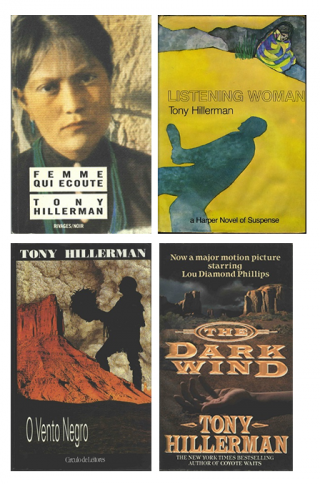by Diana Filar
Originally published on Celebrating New Mexico Statehood, 6/10/2016
Last summer, I had the pleasure of working on Hillerman’s third novel in his Navajo detective series,LISTENING WOMAN, and this semester, I have been in the throes of THE DARK WIND, the fifth novel in the series.
With the change in novels, there was a change in protagonist, and currently I am working with Jim Chee, the detective of THE DARK WIND, as opposed to Joe Leaphorn. When I first started reading, I remarked that I missed Leaphorn! I still haven’t figured out why from a literary and scholarly perspective, but as a mystery reader who will continue to read this detective series, my gut seems to be telling me that there is a relationship between these two. Even though they don’t intersect in these novels, I have the feeling they might later.
There are similarities between the detectives – both police, both members of the Navajo Tribal nation – but the main difference is that Leaphorn refuses to believe in what he deems are the superstitions of his people regarding witchcraft and the workings of good and evil. Chee, on the other hand, is training under his uncle in the ways of the people, learning sandpainting, singing, and ceremonies like the Blessing Way and Enemy Way, which come into play in other related Hillerman works.
On my first read through of THE DARK WIND, I couldn’t help but make other comparisons and notice additional contrasts with LISTENING WOMAN. The first thing I picked up on, as a literature scholar, was the format and style of the opening chapters and their influences on the later developments of both novels. Both books open “in scene” with minor characters and a big event. In the chapters following, these characters disappear, and arguably, so does the event.
In LISTENING WOMAN, the titular Navajo character is attempting to heal a man, and while she walks away to perform a ritual, both the man she hopes to heal and her assistant are murdered. In THE DARK WIND, another band of three comes upon an upturned boot that leads them to a dead body. They, too, are in the middle of preparing for a ceremony, this time the Hopi Niman Kachina. While reading both novels, I was struck by my immediate attachment, not only to the action, but also to these people, who then almost immediately, and surprisingly, seem to disappear from their respective novels.
They reappear later, and the disappearing act seems to be a strategic move on Hillerman’s part, because both the Listening Woman and the leader of the Hopi group serve as witnesses and wisdom-keepers who help solve the crime(s). They help us, the reader, gather information – information we know before the protagonist detectives – but they also help those detectives fill in the holes of knowledge they have about tribal tradition, culture, and rituals.
Even after only reading two books from Hillerman’s robust Navajo detective series, I can see the foundational elements of character, structure, and intersecting plots that are necessary to a mystery series, but which also create a world that continues to intrigue readers. Regardless of where in the world their mysteries take them, Joe Leaphorn and Jim Chee are part of that intrigue, and I can’t wait to encounter them working together in future novels.

